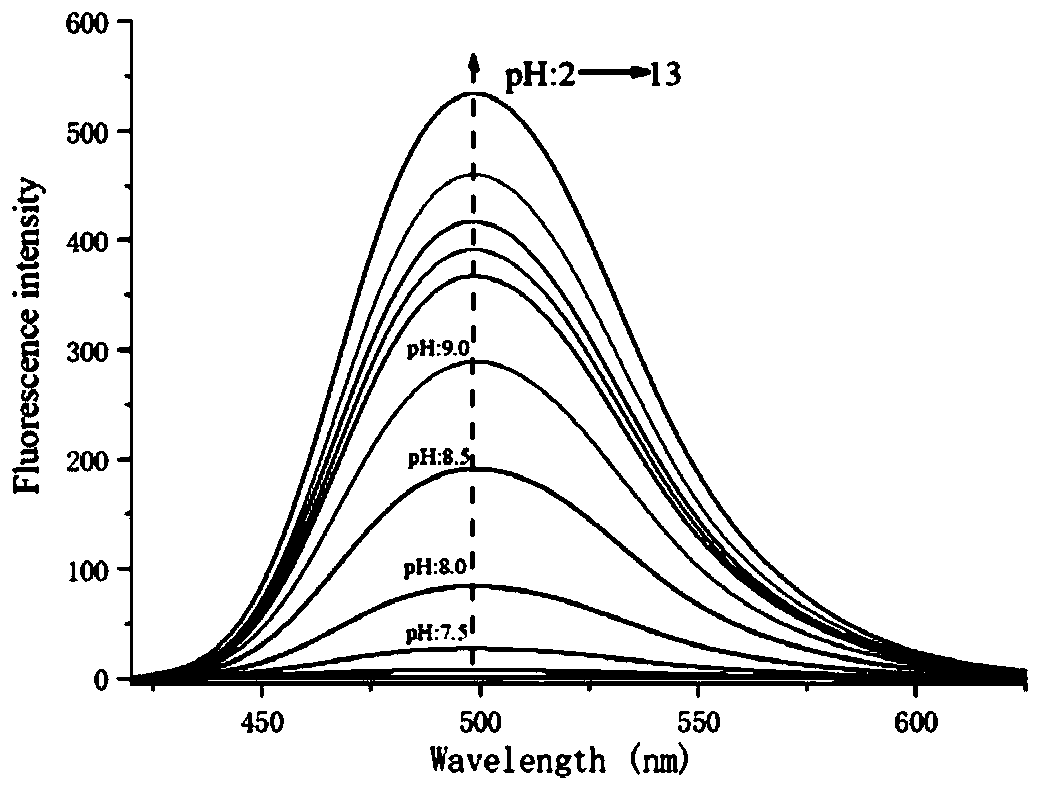Fluorescence probe for identifying cupric ions under alkaline condition and preparation method and application of fluorescence probe
A fluorescent probe, alkaline condition technology, applied in fluorescence/phosphorescence, chemical instruments and methods, luminescent materials, etc., can solve the problem that fluorescent probes cannot be used as alkaline indicators for quantitative detection, etc., and achieve resistance to other metal ions interference Strong ability, economical raw materials, good selectivity
- Summary
- Abstract
- Description
- Claims
- Application Information
AI Technical Summary
Problems solved by technology
Method used
Image
Examples
specific Embodiment approach 1
[0042] Specific embodiment 1: The fluorescent probe that recognizes copper ions under alkaline conditions in this embodiment is a covalent combination of 2-(2-hydroxyphenyl)benzothiazole and o-hydroxybenzoic hydrazide, and the fluorescent probe The structural formula is as follows:
[0043]
[0044] In this embodiment, the probe itself is in DMF / H 2 O(3 / 7, v / v, 0.01M HEPES) has almost no fluorescence emission in acidic to neutral solutions. When the solution is alkaline, the solution emits green fluorescence, and the fluorescence intensity increases with the alkaline degree of the solution. The experimental results show that the probe solution has almost no fluorescence emission in the pH range of 2-7. And when the pH range is 8-13, the solution has obvious blue-green fluorescence emission, and the greater the alkalinity of the solution, the stronger the fluorescence intensity visible to the naked eye. At the same time, under strong alkaline conditions, the fluorescence o...
specific Embodiment approach 2
[0047] Specific embodiment 2: The difference between this embodiment and specific embodiment 1 is that the fluorescent probe has a fluorescence detection limit of 1.35×10 for copper ions under the condition of pH=13. -6 M. Others are the same as in the first embodiment.
specific Embodiment approach 3
[0048] Specific embodiment 3: The difference between this embodiment and specific embodiment 1 is that the detection limit of ultraviolet absorption of the fluorescent probe to copper ions is 3.75×10 under the condition of pH=13. -7 M. Others are the same as in the first embodiment.
PUM
 Login to View More
Login to View More Abstract
Description
Claims
Application Information
 Login to View More
Login to View More - R&D
- Intellectual Property
- Life Sciences
- Materials
- Tech Scout
- Unparalleled Data Quality
- Higher Quality Content
- 60% Fewer Hallucinations
Browse by: Latest US Patents, China's latest patents, Technical Efficacy Thesaurus, Application Domain, Technology Topic, Popular Technical Reports.
© 2025 PatSnap. All rights reserved.Legal|Privacy policy|Modern Slavery Act Transparency Statement|Sitemap|About US| Contact US: help@patsnap.com



